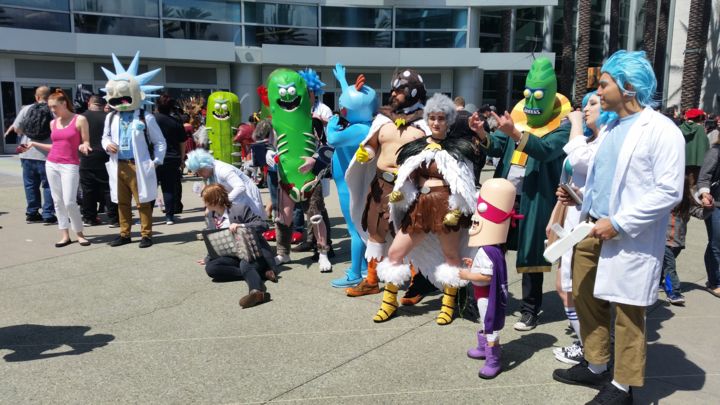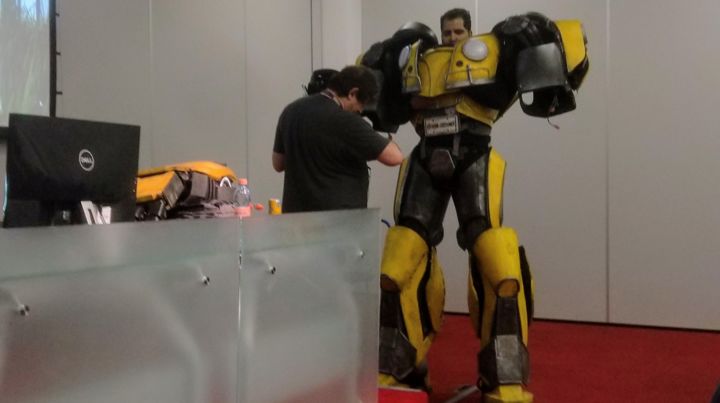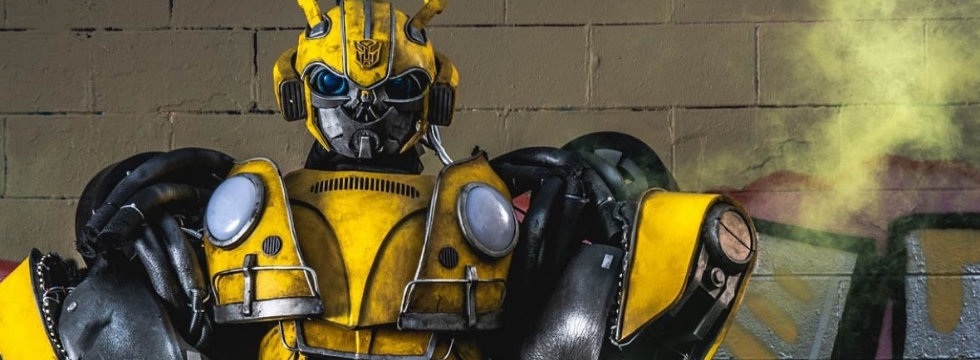author: Hank
From Pizza Joint to Cosplay God – Interview with Tom DePetrillo of Extreme Costumes
Thomas DePetrillo, the founder, lead designer, lead handler, and lead performer at Extreme Costumes, agreed to put aside his tools and discuss the wild endeavor that the Extreme Costumes is. Here is what came out of this conversation.
Table of Contents
- From Pizza Joint to Cosplay God – Interview with Tom DePetrillo of Extreme Costumes
- Nothing’s sacred
Ever since the 1990s, the community of cosplayers grows each year all over the world. What does it take to become a cosplayer? By definition, cosplay is a combination of two words – costume and play, and revolves around people who make and wear costumes and hand-crafted accessories to recreate the appearance of a selected character. Or a robot. Or a location. Oh, and even a meme.
Often times, fans of the same games and genres engage in Role-Playing and Live Action Role-Playing games, but the outsiders know them mostly from numerous Fantasy, Science Fiction, Manga, Anime events and conventions. Whatever genre or medium you can imagine, there someone is probably cosplaying it.

Some of you might have shared the experience of going to a convention and diving into hundreds, if not thousands of people dressed up as their favorite characters. Some of the costumes are minimalistic, others extremely detailed. And then there are the costumes that tower over the crowds, near-intimidating with the amount of effort you see had to be put in them. I had the pleasure of chatting with the pioneer of cosplay, the brain of Extreme Costumes, and ask him about his hobby that eventually turned into a profession.
Thomas DePetrillo, the founder, lead designer, lead handler, and lead performer at Extreme Costumes, agreed to put aside his tools and discuss the wild endeavor that the Extreme Costumes is. Here is what came out of this conversation.
The beginnings
H: Hello Thomas. How are you doing?
T: Well, I had a busy time of late but I’m recovering well so I guess that’s good.
H: And by busy time do you mean more conventions?
T: Well, I had just gone to London prior to going to Poland, and then just after Poland, I went to Canada. And prior to going to London I worked very hard for several weeks in a row without any days off trying to complete a project on time. That was successful, but it also created a lot of stress.
H: Were you working on the Bumblebee suit, or on something new?
T: The project I was finishing was something called Mangle. Mangle is a robot from the TV series called Robozuna. I was commissioned to make a Mangle costume. People who ordered it are very happy with him, so I’m happy as well. Nonetheless, during the process, there were some difficulties – I was under a very tight deadline at the end and I wanted to finish it to my satisfaction.
H: Tom, I would like to go through your history with Extreme Costumes – a hobby that eventually transformed into your profession. Could you share what was the first costume you ever made in your life?
T: I’ve been making costumes since I was 5-years old, so I’m not really sure you want to hear a recounting of when I made a ghost costume with a sheet and a couple of holes in it [laughter]. My first Extreme Costume, and just for clarification – I call things Extreme when they start to wow thousands of people – was a character, or a battle suit, known as Clan Elemental from the BattleTech universe. I built an entire human skeleton out of PVC that reproduced every joint of the human body. The skeleton had holes in it to fit my body inside. Then I went into a metal shop and learned how to process metal so that I could then wrap the entire thing head to toe in roughly five thousand sheet metal screws.
H: Impressive. So was this costume made nearly entirely out of metal?
T: No, it WAS entirely made out of metal. It was a giant nightmare. Every time I got into it or out of it I looked like I lost a fight with 20 cats.
H: How much did the costume weight?
T: Probably about a hundred pounds (app. 45kg – ed. note) but it was very small by my today’s standards – around seven feet tall. But it was incredibly awkward to walk in and maneuver. I have since learned about 22, 23 years’ worth of improvements.
Let that sink in. Over 20 years of experience in creating Extreme Costumes. Tom’s current success had humble beginnings, though. Before he was a cosplayer, around the age of 25, Tom owned a pizza joint. The business was successful and grew to 15 employees; Tom worked from 70 to 80 hours a week, but enjoyed every minute of it. What changed? After learning that he was going to be a father, he decided to sell the joint to get rid of his debts, and bought a liquor store that he ran for about a decade. It was a successful and profitable endeavor, but it required loads of time. That wasn’t a real problem until Tom and his wife learned they’ll become parents – at that point, DePetrillo decided he wants to be a father more than anything else. Now that he looks back to that period of time, he remembers he never made anyone really happy by selling a pack of cigarettes, a bottle of wine, or even a six pack of beer. And Tom loves making others happy.
And so, Tom went into sales for about a year in order to hone his natural social skills. As an autistic person, he wanted to improve his human interaction skills in order to bring his social relations up to snuff. And he did exactly that. After the brief romance with sales, Tom moved on and purchased a carwash. The idea was to own it and sort of let it handle itself, however, due to economic collapse of 2008 that turned out impossible. Owning a business that offered services not required for survival was very difficult during that challenging period of recent history. “The luxury things tended to evaporate,” Tom recalls. Yet, even though his business did not develop the way he wanted, and Tom had to spend a lot of time working at the carwash, he didn’t give up his hobby, and was constantly working on costumes.

Extreme Costumes Facebook page
T: My first costume got me around a thousand dollars. And I was very excited because I won a thousand dollars in a contest, and what enticed me most was the big crowd cheering. By the time I had gotten into the carwash business, I’d already gotten my first commercial engagements. It was moving from being a just a hobby that might provide ten to fifteen thousand dollars a year from prize winnings, up to getting contracts for doing jobs like appearing at events for companies such as Chevy. And when I continued to do that while running the carwash, I eventually got that volume up to about forty thousand dollars a year.
How to become a pro
And at this stage, Thomas decided to cross the Rubicon. He talked to his wife about selling the carwash – they agreed that he should devote all of his time to costume making. And boy, am I glad they took that leap. Initially, Tom was working on his own. Then, he invited another likeminded person to work with him. Ever since, his Extreme Costumes business continues to grow. Currently, Tom employs three full-time, and twelve part-time costume enthusiasts. Those working part-time are mostly professionals in specific fields. For example, all Extreme Costumes have an aluminum skeleton, thus an aluminum welder is needed every once in a while to create the skeleton for a new project. Given how much work has to be put into a particular suit after the skeleton is completed, the welder will have a couple days of work once every several weeks. However, and interestingly enough, the real job for most people starts when the costume is ready, as there are lots of things to take care of:
T: Well, there are the performers – guys in suit praised by everyone who see them inside that particular suit. However, without a handler that person is useless – these people are essential for the success of an Extreme Costume. Handlers will help performers get into the suit, get out of the suit, help steer them around dangerous obstacles, they might prevent someone who is touching a performer from inappropriately touching him, but they also could peel of a small child who’s grasping and pulling at stuff. Moreover, they could deflect unwanted attention from someone who a performer does not wish to have contact with. A good handler can notice the threat before it happens and eliminate it before there is any danger. All of my Extreme Costumes run on stilts. All of them have some measure of blocking your vision or hearing. Even though my performers are highly-trained that doesn’t mean that they don’t need a good handler.
It’s quite interesting to learn how important the handlers are for a cosplayer. Tom recalls one visit to a Vegas night club with a handler he’d thought was sufficiently trained. At one point, though, the handler watched a person come up from behind Tom, reach out, grab his codpiece, and start yanking at it. To make things even more awkward, the handler, instead of helping Tom, laughed at the situation and reached for his phone to take some pictures. “I could fall on someone else and potentially injure them. Although it’s not likely, what’s the point of bringing a handler if they don’t look for the safety of the performer first? Thus, all my new people have more stringent standards.

